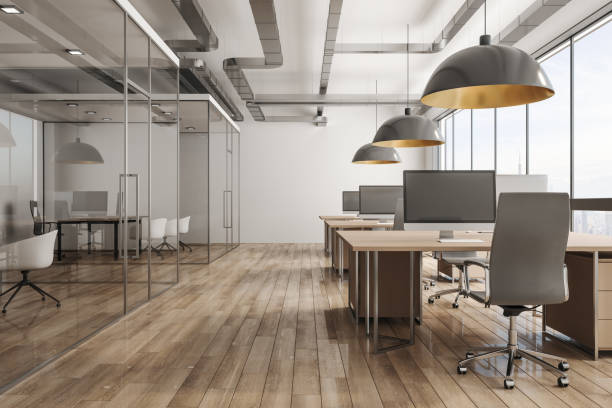Introduction
In the ever-evolving corporate world, office spaces play a crucial role in fostering productivity, creativity, and employee well-being. Gone are the days of bland, cookie-cutter work environments. Today, forward-thinking organizations are embracing the power of innovative interior design to create inspiring, functional, and aesthetically pleasing corporate office spaces. In this article, we will delve into the realm of corporate office interior design, exploring the latest trends, cutting-edge concepts, and their impact on employee satisfaction and business success.

1. The Power of Purposeful Design:
A corporate office is more than just a place to work. It should embody the company’s culture, values, and aspirations. Purposeful design elements, such as open layouts, collaborative spaces, and flexible workstations, are gaining popularity. These design choices promote interaction, communication, and the free flow of ideas, ultimately boosting employee engagement and innovation.
2. Biophilic Design: Bringing Nature Indoors:
One of the most exciting trends in corporate office interior design is biophilic design. Incorporating natural elements like plants, green walls, and natural light not only enhances aesthetics but also improves air quality and creates a soothing ambiance. If you’re looking for more exciting ideas about corporate office interior design, you can read through this link, https://zenitharc.com.sg/office-interior-design/. Biophilic design has been proven to reduce stress levels, increase productivity, and enhance overall well-being.
3. Adaptive Workspaces: Embracing Flexibility:
The traditional concept of assigned desks is gradually giving way to flexible and adaptive workspaces. Hot desking, shared workstations, and multipurpose areas are becoming the norm. These dynamic environments allow employees to choose the most suitable space for their work requirements, fostering collaboration, creativity, and a sense of autonomy.
4. Ergonomics: Prioritizing Employee Health:
A healthy workforce is a productive workforce. Corporate offices are now investing in ergonomic furniture, adjustable desks, and ergonomic accessories to ensure the well-being of their employees. Designing spaces that promote proper posture, reduce physical strain, and provide comfort throughout the workday not only enhances productivity but also reduces the risk of work-related injuries and musculoskeletal disorders. To further support employee well-being and productivity, many businesses are also incorporating mobile training desks into their office layouts, allowing for versatile and collaborative workspaces that can adapt to various training and meeting needs.
5. Technology Integration: Creating Smart Offices:
The digital age has transformed the way we work, and corporate office design is no exception. Smart offices are emerging as a prominent trend, incorporating state-of-the-art technology to streamline operations, enhance connectivity, and improve efficiency. From smart lighting and temperature control systems to integrated communication tools, technology integration in office design is revolutionizing the modern workplace.

6. Sensory Experiences: Stimulating the Senses:
Corporate offices are moving beyond visual aesthetics by incorporating multisensory experiences into their design. Ambient soundscapes, soothing music, and pleasant scents are being used strategically to create a positive and engaging atmosphere. Sensory design elements help reduce distractions, boost focus, and create a memorable and immersive workplace environment.
7. Sustainability: Designing with a Conscience:
As environmental concerns continue to gain momentum, sustainability has become an integral aspect of corporate office interior design. Employing energy-efficient lighting, utilizing eco-friendly materials, and incorporating recycling stations are just a few ways offices are going green. By embracing sustainable design practices, companies demonstrate their commitment to the planet while inspiring their employees to do the same.
Conclusion
Corporate office interior design has evolved significantly in recent years, reflecting the changing dynamics of the modern workplace. By embracing purposeful design, biophilic elements, adaptability, ergonomic considerations, technology integration, sensory experiences, and sustainability, companies can create office spaces that inspire, engage, and empower their employees. A well-designed corporate office is not only aesthetically pleasing but also a catalyst for productivity, creativity, and overall business success. The future of office design lies in the hands of visionary organizations that understand the power of a thoughtfully crafted environment in shaping their company culture and driving innovation.